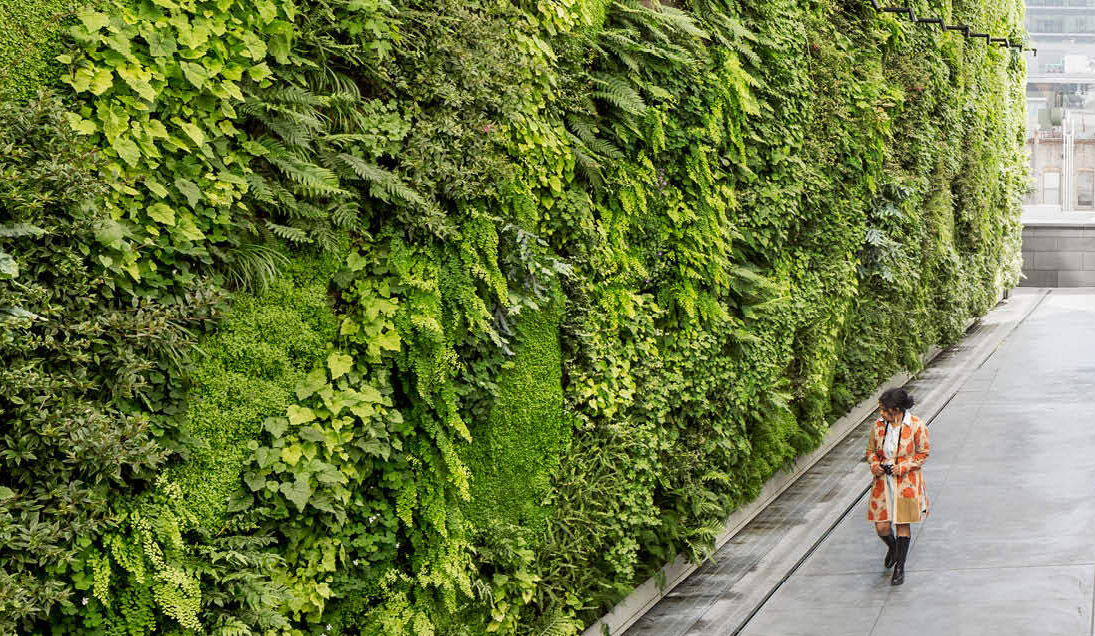The Rise of Vertical Green Walls in Modern Architecture
Urban landscapes are rapidly evolving, and among the most remarkable shifts is the integration of nature into architecture. The vertical green wall system stands out as one of the most innovative design solutions in modern cities. It combines engineering and horticulture, transforming ordinary walls into lush living surfaces. As more cities embrace sustainability, vertical gardens are no longer just decorative—they are essential components of green infrastructure. These living walls symbolize a commitment to environmental consciousness and a desire to create breathable, energy-efficient buildings. Developers, architects, and urban planners now view them as an investment in both ecological and aesthetic value. Across the world, from Singapore to New York, these installations redefine how people experience city spaces—merging functionality, beauty, and sustainability in a single design feature.
Understanding What a Vertical Green Wall System Is
A vertical green wall system is essentially a structure where vegetation grows on vertically suspended panels, supported by an integrated irrigation and drainage system. It is a self-sustaining ecosystem, designed to bring the benefits of greenery into areas where traditional gardening isn’t possible. These walls may include a variety of plants—ferns, vines, succulents, and flowering species—that thrive depending on the location and light exposure. The system typically includes an irrigation setup that distributes water evenly, ensuring all plants remain healthy and vibrant.
There are two main types of systems: green façades, where climbing plants grow on a supporting structure, and living walls, which use pre-vegetated panels. Both serve aesthetic and ecological functions, helping to purify the air and reduce ambient temperatures. What makes these systems unique is their adaptability—they can be installed indoors or outdoors, on small residential walls or massive commercial buildings. Beyond their beauty, these walls showcase how design can coexist with nature, bringing a refreshing balance between man-made and natural elements.
The Environmental Impact of Vertical Green Wall Systems
The environmental benefits of green walls are profound. In urban areas plagued by pollution and high heat retention, a vertical green wall system acts as a natural filter and temperature regulator. By absorbing carbon dioxide and releasing oxygen, these walls enhance air quality and help reduce the urban heat island effect. Additionally, they provide insulation that minimizes the need for heating and cooling systems, leading to reduced energy consumption and lower utility costs.
A well-designed vertical wall also promotes biodiversity. The plants attract pollinators like bees and butterflies, while creating microhabitats for small species of birds and insects. Sustainable irrigation techniques, such as using recycled greywater, further reduce the ecological footprint of these systems. Urban planners are now viewing green walls not only as beautification tools but as essential contributors to sustainable city planning. When integrated with renewable energy systems and eco-friendly materials, green walls become part of a city’s larger environmental strategy, improving the health and well-being of residents.
Enhancing Urban Aesthetics and Human Well-Being
Green walls don’t just purify the air—they uplift the human spirit. Their visual appeal transforms plain concrete structures into living art pieces that soothe and inspire. Research has shown that exposure to greenery, even in vertical form, can reduce stress, increase focus, and enhance overall happiness. In office spaces, for example, workers exposed to biophilic design elements often experience higher productivity and creativity.
Cities that integrate vertical green wall systems experience a more inviting atmosphere. These walls soften harsh architectural lines and create a sense of tranquility in dense urban environments. By combining visual pleasure with environmental function, vertical gardens elevate the urban aesthetic to a new level. They are living reminders that nature belongs not just in parks or countryside areas but in the very heart of modern cities.
Design and Installation Process of a Vertical Green Wall System
Building a vertical green wall system requires strategic planning and expert craftsmanship. The process begins with assessing the site conditions—sunlight exposure, wind direction, wall orientation, and load-bearing capacity. Once the location is suitable, designers choose plants that align with the environmental conditions and desired look. Proper irrigation and drainage systems are crucial to prevent waterlogging and ensure consistent hydration.
The installation steps usually include:
- Preparing the wall surface and structural support
- Installing the panel or modular system
- Setting up the irrigation and drainage lines
- Planting selected species
- Testing the water and nutrient delivery system
Each stage demands precision, as the long-term success of the wall depends on both the quality of materials and ongoing maintenance. A well-installed system not only enhances aesthetics but also ensures sustainable performance for years to come.
Maintenance and Longevity of Vertical Green Walls
For a vertical green wall to remain vibrant, regular care is essential. Maintenance typically involves checking the irrigation system, pruning overgrown plants, and replacing any unhealthy vegetation. Fertilization schedules are set to ensure nutrients are distributed evenly across the wall. With modern technology, many systems now include automated monitoring that tracks soil moisture, temperature, and nutrient levels in real time.
Indoor green walls may need artificial lighting, while outdoor installations require weather-resistant plants and periodic trimming. Over time, maintenance costs can be managed effectively through sustainable practices and professional oversight. When properly cared for, a vertical green wall system can thrive for decades, maintaining its beauty and environmental value without excessive upkeep.
The Economic and Social Value of Vertical Green Wall Systems
Beyond environmental advantages, green walls bring tangible economic and social benefits. For property owners, these installations can significantly increase a building’s value. They improve insulation, resulting in energy savings, and enhance the building’s appeal to tenants and customers. Businesses that adopt green walls also gain a positive brand image, reflecting a commitment to sustainability and innovation.
On a larger scale, these systems contribute to a healthier community by improving air quality and encouraging outdoor engagement. Many buildings that feature vertical green walls are recognized under international sustainability certifications such as LEED or BCA Green Mark. The growing adoption of these systems across commercial, residential, and public spaces proves that green design is not just a trend—it’s a movement reshaping the future of architecture.
Future Trends in Vertical Green Wall Technology
Technology continues to redefine what’s possible in green architecture. The future of vertical green wall systems lies in automation, smart irrigation, and integration with IoT (Internet of Things). These advancements make maintenance more efficient while optimizing water and nutrient use. Artificial intelligence is also being applied to monitor plant health, predicting potential issues before they escalate.
Emerging innovations include modular green wall kits that allow for flexible installation, even in compact spaces. New sustainable materials, such as lightweight biodegradable substrates, are also gaining traction. As cities strive to reduce carbon footprints, the role of vertical greenery in urban ecosystems will expand further—transforming how we design, live, and interact with our built environments.
Choosing the Right Vertical Green Wall System for Your Space
Selecting the right system involves careful planning. Factors such as available sunlight, wind exposure, and wall orientation determine which plants and irrigation systems will work best. For indoor spaces, low-light plants and efficient lighting solutions are ideal, while outdoor walls benefit from native or drought-resistant species.
Here are key considerations when planning your installation:
- Evaluate structural integrity and available space
- Choose plants based on light and climate conditions
- Opt for energy-efficient irrigation systems
- Partner with professional installers experienced in green architecture
- Plan a maintenance schedule suited to your wall’s environment
When done right, your vertical green wall becomes more than just a design statement—it becomes a living, breathing system that improves your surroundings.
Frequently Asked Questions (FAQ)
Q1: What’s the difference between a vertical garden and a vertical green wall system?
A vertical garden is a general term for growing plants vertically, while a vertical green wall system refers to an engineered structure with irrigation and drainage components.
Q2: How often does a green wall need maintenance?
Most walls require monthly maintenance, but some systems with automated irrigation need less frequent care.
Q3: Can a vertical green wall system be installed indoors?
Yes, many systems are designed for indoor use and can thrive with proper lighting and temperature control.
Q4: Are green walls expensive to maintain?
Initial costs can be high, but energy savings and increased property value often offset long-term expenses.
Q5: What types of plants thrive best in vertical green wall systems?
Ferns, philodendrons, pothos, succulents, and mosses are common choices due to their adaptability and resilience.
Q6: How does a vertical green wall improve building insulation?
The wall creates a natural thermal barrier, reducing heat absorption and improving overall energy efficiency.
The Growing Role of Vertical Green Walls in a Sustainable Future
As cities expand, integrating green technology becomes vital to maintaining environmental balance. The vertical green wall system embodies this harmony by merging modern design with nature’s resilience. It redefines how we experience architecture—turning cold, hard surfaces into vibrant ecosystems that breathe life into urban settings.
Takeaway
Vertical green wall systems are more than architectural accents—they are a step toward a sustainable and harmonious future. By combining design innovation, environmental responsibility, and technological advancement, these living walls offer beauty, functionality, and a breath of fresh air in every sense. For architects, developers, and eco-conscious individuals, embracing this green revolution is not just an option—it’s a responsibility to the planet we share.






